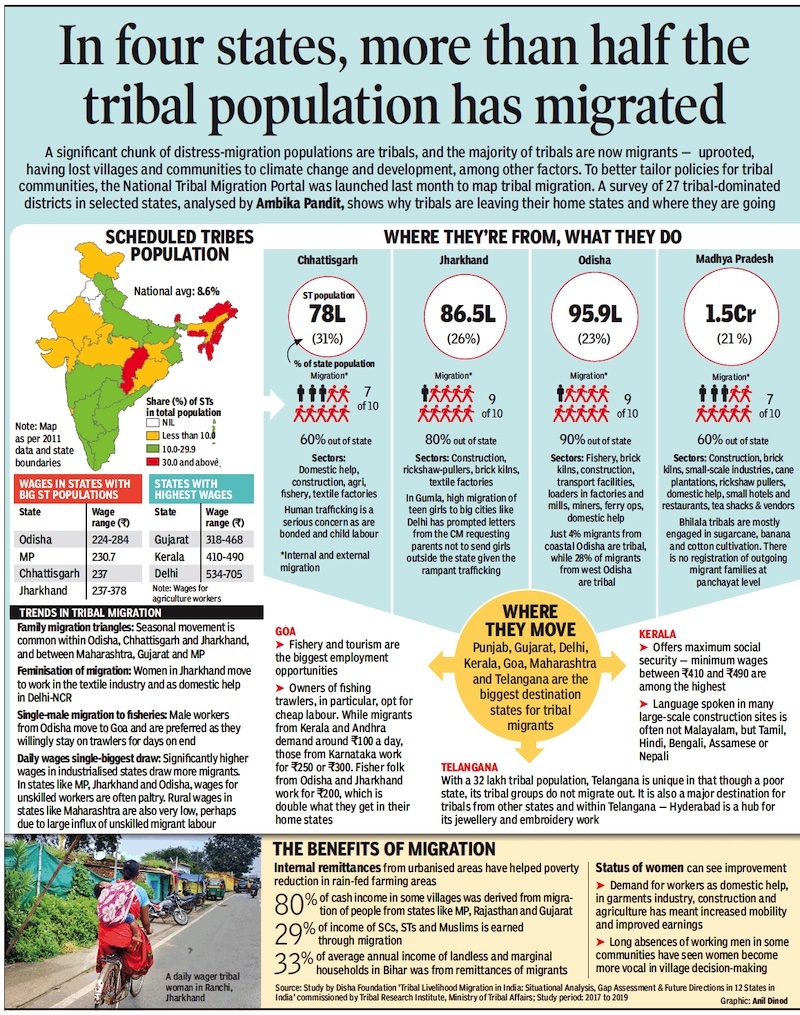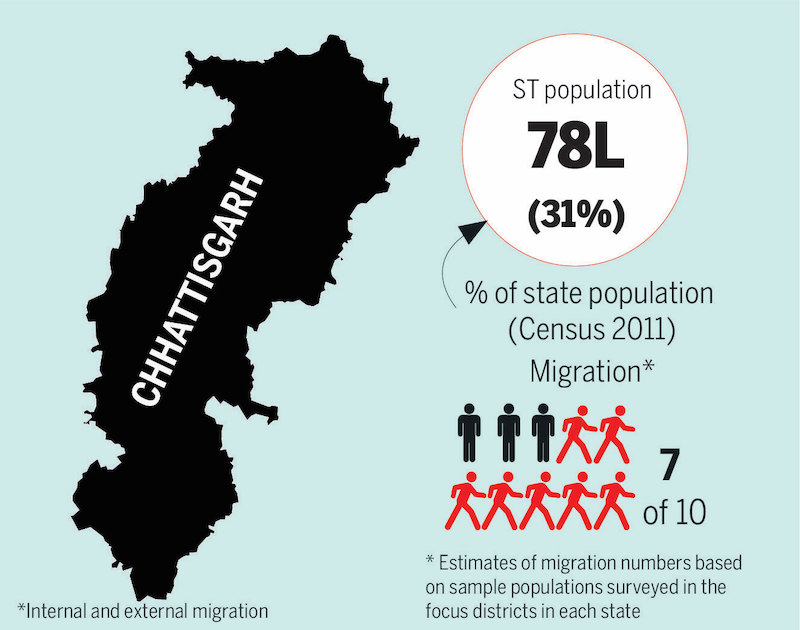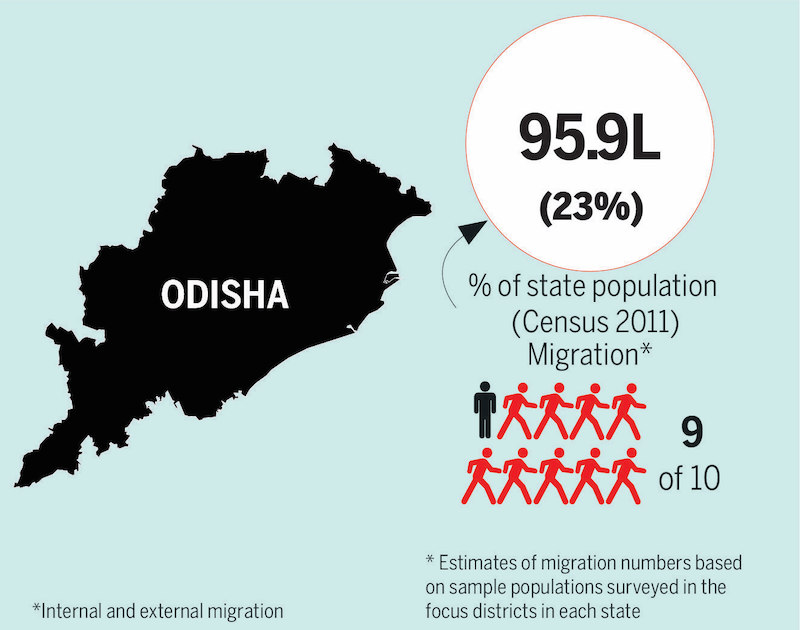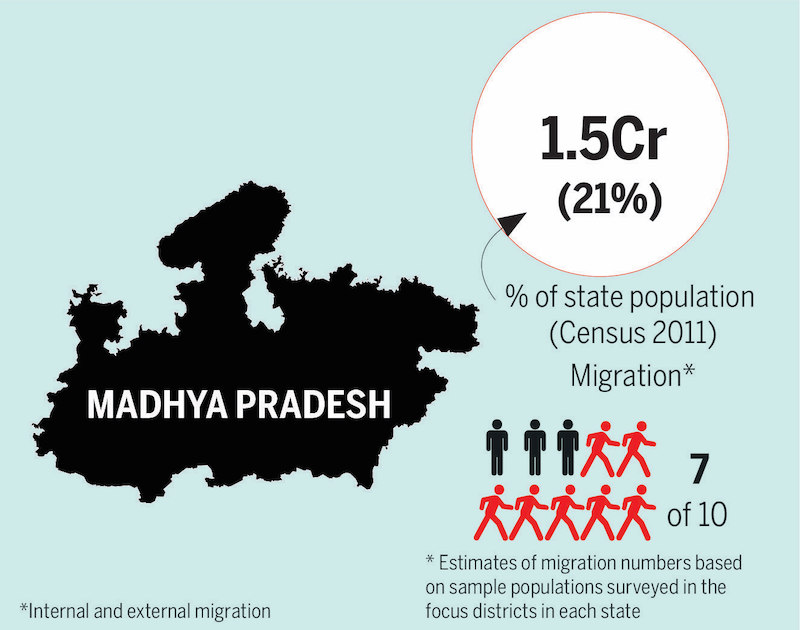Tribal population: India
This is a collection of articles archived for the excellence of their content. |
Overview
As in 2017-19

From: February 16, 2021: The Times of India

From: Ambika Pandit, February 17, 2021: The Times of India

From: Ambika Pandit, February 17, 2021: The Times of India

From: Ambika Pandit, February 17, 2021: The Times of India

From: Ambika Pandit, February 17, 2021: The Times of India
See graphics:
India’s Tribal population, As in 2017-19
% of state ST population in Chhattisgarh, 2011.
% of state ST population in Jharkhand, 2011.
% of state ST population in Odisha, 2011.
% of state ST population in Madhya Pradesh, 2011.
Ambika Pandit, February 17, 2021: The Times of India
The coronavirus pandemic has put the spotlight on India's 'invisible' migrant population. A significant chunk of distress-migration population is tribal, and the majority of tribals are now migrants — uprooted, having lost villages and communities to climate change and development, among other factors. To better tailor policies for tribal communities, the National Tribal Migration Portal was launched last month to map tribal migration.
A survey of 27 tribal-dominated districts in selected states, analysed by TOI, shows why tribals are leaving their home states and where they are going.
WHERE THEY'RE FROM AND WHAT THEY DO
A significant portion of the tribal population in the four states of Chhattisgarh, Jharkhand, Odisha and Madhya Pradesh has migrated to other states in hope of better employment opportunities.
Sectors: Domestic help, construction, agriculture, fishery and textile factories.
However, human trafficking is a serious concern as are bonded and child labour.
Sectors: Construction, rickshaw-pullers, brick kilns, textile factories.
In Gumla, high migration of teen girls to big cities like Delhi has prompted letters from the chief minister requesting parents not to send girls outside the state given the rampant trafficking.
Sectors: Fishery, brick kilns, construction, transport facilities, loaders in factories and mills, miners, ferry operations, domestic help, drivers.
Just 4% of migrants from coastal Odisha are tribal, while 28% of migrants from west Odisha are tribal.
Sectors: Construction, brick kilns, small-scale industries, cane plantations, rickshaw pullers, domestic help, small hotels and restaurants, tea shacks & vendors.
Bhilala tribals are mostly engaged in sugarcane, banana and cotton cultivation. There is no registration of outgoing migrant families at panchayat level.
WHERE THEY MOVE
Goa, Punjab, Delhi, Kerala, Maharashtra and Telangana are the biggest destination states for tribal migrants.
GOA
- Fishery and tourism are the biggest employment opportunities in Goa.
- Owners of fishing trawlers, in particular, opt for cheap labour. While migrants from Kerala and Andhra Pradesh demand around Rs 100 a day, those from Karnataka work for Rs 250-300, depending on the demand. Fisher folk from Odisha and Jharkhand work for Rs 200, which is double what they get in their home states.
KERALA
- Kerala offers maximum social security — minimum wages between Rs 410 and Rs 490 are among the highest.
- Language spoken in many large-scale construction sites is often not Malayalam, but Tamil, Hindi, Bengali, Assamese, or Nepali.
- Buses in several areas ply with boards in Hindi and Bengali. Theatres run movies from Bengal, Assam and Odisha.
TELANGANA
- With a 32 lakh tribal population (9% of the state's population), Telangana is unique in that though a poor state, its tribal groups do not migrate out. It is also a major destination for tribals from other states and within Telangana — Hyderabad is a hub for its jewellery and embroidery work.
TRENDS IN TRIBAL MIGRATION
Family migration triangles: Seasonal movement is common within Odisha, Chhattisgarh and Jharkhand, and between Maharashtra, Gujarat and Madhya Pradesh. Feminisation of migration: Women in Jharkhand move to work in the textile industry and as domestic help in the Delhi-NCR region. Single-male migration to fisheries: Single-male workers from Odisha move to Goa. They are preferred as they willingly stay on trawlers for days on end.
Daily wages single-biggest draw: Significantly higher wages in industrialised states draw more migrants. In states like MP, Jharkhand and Odisha, wages for unskilled workers are often paltry. Rural wages in states like Maharashtra are also very low, perhaps due to large influx of unskilled migrant labour.
WHY THEY ARE MOVING
Higher daily wage rate at destination states is a major factor for migration. For instance, an unskilled worker in Kerala gets wages two-and-a-half times higher than the prevailing wages in Kota (Rajasthan) and Varanasi (UP). Driven by vulnerabilities, these tribal migrants are joining the informal labour force where they sometimes face unsafe conditions and wage-related harassment, among other concerns.
THE BENEFITS OF MIGRATION
Internal remittances from urbanised areas have helped poverty reduction in rain-fed farming areas
- 80% of cash income in some villages was derived from migration of people from states like MP, Rajasthan and Gujarat.
- 29% of income of SCs, STs and Muslims is earned through migration.
- 33% of average annual income of landless and marginal households in Bihar was from remittances of migrants.
Status of women can see improvement
- Demand for workers as domestic help, in garments industry, construction and agriculture has meant increased mobility and improved earnings.
- Long absences of working men in some communities have seen women become more vocal in village decision-making.
An online home for migrant tribals
It’s early days for the National Tribal Migration Portal, an ambitious project that hopes to map the universe of tribal migrants by numbers and occupation, by challenges to their livelihood and way of life. The mobile application will capture and upload migration data right down to the village level. The purpose of putting all this together is to eventually be able to stitch policies that suit tribal people.
Source : Study by Disha Foundation 'Tribal Livelihood Migration in India: Situational Analysis, Gap Assessment & Future Directions in 12 States in India' commissioned by Tribal Research Institute (TRI), Ministry of Tribal Affairs (MoTA) Study period: 2017 to 2019